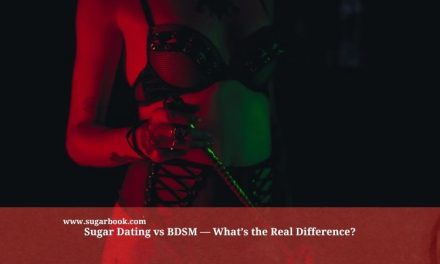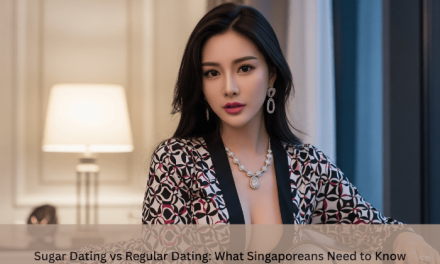
Meet successful sugar daddies and confident sugar babies on the world’s leading sugar dating app. Join free today.
In today’s evolving landscape of identity and relationships, terms like “demiromantic” are becoming more visible and relevant. But what does demiromantic actually mean, and why is it important to understand this identity in the context of modern relationships?
As society grows more inclusive of different romantic and sexual orientations, acknowledging the experiences of demiromantic individuals becomes essential. This article dives deep into the demiromantic identity, how it works, where it fits within the LGBTQ+ spectrum, and what it means for people who experience love only after forming a deep emotional connection.
Contents
- Demiromantic Meaning and Identity
- Demiromantic and the LGBTQ+ Spectrum
- How Being Demiromantic Feels in Daily Life
- Demiromantic Relationships: What They Look Like
- Common Misconceptions About Being Demiromantic
- Coming Out as Demiromantic
- Why the Demiromantic Identity Matters
- How to Support Someone Who Is Demiromantic
- Demiromantic in Pop Culture and Representation
- Final Thoughts on the Demiromantic Identity
- Ethical Non Monogamy Explained: What Does It Really Mean?
- Ethical Non Monogamy vs Polyamory: Are They the Same?
- Ethical Non Monogamy in Modern Dating Culture
- Types of Ethical Non Monogamy Relationships
- Ethical Non Monogamy and Communication: The Foundation of Trust
- Ethical Non Monogamy and Jealousy: Managing Emotions with Maturity
- Ethical Non Monogamy and Boundaries: Defining Agreements
- Ethical Non Monogamy and Inclusivity: Welcoming All Orientations and Genders
- Ethical Non Monogamy in Long-Term Relationships
- Ethical Non Monogamy Myths and Misconceptions
- Ethical Non Monogamy and Mental Health
- Should You Try Ethical Non Monogamy?
- Final Thoughts on Ethical Non Monogamy
- FAQ
Demiromantic Meaning and Identity
The term demiromantic refers to someone who does not experience romantic attraction to another person unless they have first formed a strong emotional bond with them. For a demiromantic individual, romantic feelings don’t typically develop based on appearance or surface-level interactions. Instead, those feelings arise only after trust, connection, and intimacy are established on a deeper emotional level.
The demiromantic identity falls under the umbrella of the aromantic spectrum, which includes a range of experiences related to low or conditional romantic attraction. While someone who is aromantic may not experience romantic attraction at all, a demiromantic person does—but only after that emotional bond is formed.
This nuance is essential in understanding the unique way demiromantic people relate to love and relationships.
Demiromantic and the LGBTQ+ Spectrum
The demiromantic label is part of a broader conversation about romantic orientation, which is different from sexual orientation. While sexual orientation refers to who someone is sexually attracted to, romantic orientation refers to who someone is romantically attracted to whether or not sexual feelings are involved.
Someone who identifies as demiromantic may also be straight, gay, bisexual, pansexual, or asexual. For example, a person may be demiromantic and bisexual, meaning they develop romantic feelings only after emotional bonding, and those feelings can be for people of multiple genders.
The demiromantic identity is significant within the LGBTQ+ spectrum because it emphasizes the importance of emotional connection in love and dating. It also highlights the diversity of how people experience attraction, beyond just physical or sexual cues.
How Being Demiromantic Feels in Daily Life
For demiromantic individuals, dating can feel different than it does for others. In many dating cultures, especially those centered on apps or fast-paced meetups, people are often expected to feel romantic chemistry quickly. But a demiromantic person may not feel anything at first.
This doesn’t mean they’re cold or uninterested, it means that their romantic orientation requires time, closeness, and shared vulnerability before any spark is felt.
Some challenges demiromantic people face include:
-
Feeling out of place in hookup cultures
-
Being misunderstood as “just friends” or emotionally distant
-
Struggling to explain their identity to potential partners
-
Being pressured to move quickly in relationships
But there are also strengths in being demiromantic:
-
Valuing emotional intimacy and trust
-
Building stronger, longer-lasting romantic relationships
-
Prioritizing deep connection over superficial attraction
Understanding the demiromantic experience helps normalize a different—but equally valid, way of loving and bonding.
Demiromantic Relationships: What They Look Like
A relationship involving a demiromantic person is likely to progress slowly, especially in the early stages. A demiromantic individual might start out feeling completely platonic toward someone, only to develop romantic interest later on—after shared experiences and emotional depth have built a foundation.
In some cases, the other person might not even know that romantic attraction is a possibility until it happens. That’s why communication is key. Being upfront about being demiromantic helps avoid confusion and fosters trust between both partners.
In committed relationships, a demiromantic person may:
-
Need reassurance that emotional bonding remains central
-
Prefer deeper conversations over physical flirtation
-
Feel more invested in emotional intimacy than physical attraction
-
Thrive in relationships built on mutual respect and trust
These dynamics aren’t better or worse than any other—they’re simply different. And for people who value emotional connection as the gateway to romance, the demiromantic identity helps define that journey.
Common Misconceptions About Being Demiromantic
As with many lesser-known orientations, there are plenty of myths surrounding the demiromantic label. Let’s clarify a few of the most common misconceptions:
Myth: Demiromantic people are just shy or afraid of intimacy.
Reality: Being demiromantic is not about fear—it’s a specific orientation. A demiromantic person may desire deep relationships; they just don’t feel romantic attraction unless that emotional bond is first established.
Myth: Demiromantic is just another word for being picky.
Reality: Picky implies a conscious choice. Demiromantic attraction isn’t chosen—it’s how a person is wired to experience romance.
Myth: Demiromantic people can’t fall in love.
Reality: They absolutely can. In fact, when romantic attraction does develop, it’s often deeply felt and meaningful because it’s rooted in emotional connection.
Myth: Everyone is a little demiromantic.
Reality: While many people enjoy emotional bonding in relationships, not everyone requires it to feel romantic attraction. The demiromantic experience is specific and shouldn’t be minimized.
By debunking these myths, we make space for demiromantic people to be seen, validated, and respected.
Coming Out as Demiromantic
For many people, discovering the demiromantic identity brings relief and self-understanding. But coming out can still be challenging—especially when others don’t know what the term means or question its validity.
If you’re thinking of coming out as demiromantic, here are a few tips:
-
Learn the language: Understanding how to define demiromantic clearly helps others understand.
-
Share resources: Offer articles or videos that explain the concept.
-
Be patient: Some people may need time to adjust to new terms and ideas.
-
Seek community: Online forums, LGBTQ+ support groups, and social media can offer solidarity and shared experiences.
You don’t have to come out to everyone. Your identity is yours, and you can choose when, how, and to whom you disclose it.
Why the Demiromantic Identity Matters
The demiromantic identity matters because it reflects the diversity of human connection. Not everyone experiences love the same way, and recognizing that helps create a more inclusive, compassionate world.
It also challenges fast-paced, attraction-based dating norms and reminds us that emotional connection can be the heart of romance—not just an added bonus. For those who often feel “different” in how they relate to others romantically, the demiromantic label offers clarity and confidence.
When demiromantic individuals are acknowledged and accepted, the entire spectrum of romantic orientation becomes more visible and valid.
How to Support Someone Who Is Demiromantic
If someone in your life identifies as demiromantic, your support can make a big difference. Here’s how you can be an ally:
-
Listen without judgment
-
Avoid pushing them into faster romantic dynamics
-
Validate their experience, even if it’s different from yours
-
Ask questions respectfully and avoid assumptions
-
Use their preferred identity language when talking about them
Being demiromantic isn’t a limitation – it’s a beautiful way of loving with intention and depth. By supporting demiromantic people, we promote a richer, more inclusive understanding of romance.
Demiromantic in Pop Culture and Representation
Unfortunately, demiromantic characters are still rare in mainstream media. Most romantic storylines jump straight into romantic or sexual chemistry, leaving little room for identities like demiromantic that thrive on slow-building emotional connections.
However, some characters in fiction do reflect demiromantic experiences, even if not explicitly labeled. Viewers and readers often see themselves in characters who start out as friends and slowly realize romantic feelings only after deep bonding. This type of representation, while subtle, is meaningful.
More open representation of demiromantic individuals in books, movies, and shows would not only validate real-life experiences but also educate broader audiences about the spectrum of romantic orientations.
Final Thoughts on the Demiromantic Identity
Being demiromantic is not a phase, a preference, or a problem -it’s a legitimate identity within the vast world of romantic orientation. For those who only fall in love after meaningful emotional connection, the demiromantic label provides clarity and empowerment.
As we continue to explore and affirm diverse identities, making space for demiromantic voices is essential. Whether you identify as demiromantic, are exploring your romantic orientation, or simply want to be a better ally, understanding this identity can deepen empathy and reshape how we think about love.
In a world that often celebrates instant chemistry and quick romance, the demiromantic identity reminds us that sometimes, love takes time—and that’s not only okay, but beautiful.
In a world where dating apps have expanded our choices and traditional relationship models are evolving, more people are exploring relationship styles outside of monogamy. One term rising in popularity and practice is ethical non monogamy. But what exactly does it mean, and how does it work?
This article will guide you through the ins and outs of ethical non monogamy—what it means, how it’s practiced, the differences from infidelity or open relationships, and why it’s increasingly relevant in today’s dating culture. Whether you’re curious, exploring, or actively practicing ethical non monogamy, this comprehensive guide will help you understand the values and structure that support this relationship style.
Ethical Non Monogamy Explained: What Does It Really Mean?
Ethical non monogamy, often abbreviated as ENM, refers to any relationship style in which people openly and consensually engage in romantic or sexual relationships with more than one person. The “ethical” part is essential – it means that all involved parties are aware, consenting, and respectful of each other’s boundaries and needs.
Unlike cheating, which involves secrecy and betrayal, ethical non monogamy is grounded in transparency, trust, and communication. This approach challenges the one-size-fits-all model of love and acknowledges that multiple loving or intimate connections can coexist when handled with honesty.
At its core, ethical non monogamy prioritizes:
-
Informed consent
-
Open communication
-
Emotional responsibility
-
Respect for autonomy
Ethical non monogamy isn’t about being reckless or avoiding commitment—it’s about creating custom relationship structures that align with personal values and emotional truths.
Ethical Non Monogamy vs Polyamory: Are They the Same?
While often used interchangeably, ethical non monogamy is a broader umbrella under which polyamory falls. Ethical non monogamy includes many relationship types where more than one connection is formed, but not all are polyamorous.
Polyamory specifically refers to having multiple romantic relationships simultaneously with the knowledge and consent of everyone involved. Ethical non monogamy, however, could also include:
-
Open relationships
-
Swinging
-
Relationship anarchy
-
Solo polyamory
-
Hierarchical and non-hierarchical structures
So, while all polyamorous relationships are forms of ethical non monogamy, not all ethically non-monogamous relationships are polyamorous.
Ethical Non Monogamy in Modern Dating Culture
As traditional dating norms evolve, ethical non monogamy is becoming more visible and accepted. Dating apps like OkCupid, Feeld, and Tinder now allow users to identify as non-monogamous or ethically non-monogamous, helping people find like-minded partners.
The rise of ethical non monogamy in modern dating signals a shift toward personalization and honesty in relationships. For some, monogamy feels limiting or unnatural. Ethical non monogamy offers an alternative that emphasizes choice and autonomy, rather than conformity.
People choose ethical non monogamy for various reasons:
-
Desire for multiple emotional or sexual connections
-
Avoiding social pressure to settle down traditionally
-
Aligning with a philosophical belief in relationship freedom
-
Seeking new forms of intimacy or exploration
Regardless of the reason, ethical non monogamy opens space for more inclusive and diverse expressions of love.
Types of Ethical Non Monogamy Relationships
Understanding the variations of ethical non monogamy can help clarify what relationship styles may work best for you. Here are the most common types:
Polyamory
This form of ethical non monogamy involves having multiple romantic partners, often with emotional depth and commitment. These relationships can be hierarchical (e.g., primary, secondary) or non-hierarchical.
Open Relationships
Couples may remain emotionally monogamous but allow sexual experiences outside the partnership. This is one of the most recognizable forms of ethical non monogamy.
Swinging
Often practiced by couples, swinging involves engaging in consensual sexual activities with others, typically in social settings like parties or clubs.
Relationship Anarchy
A radical form of ethical non monogamy that rejects traditional labels and rules. Each connection is treated individually, without predefined expectations.
Solo Polyamory
Individuals who practice solo polyamory maintain multiple relationships but prioritize independence, often avoiding traditional nesting or cohabitation dynamics.
Each type of ethical non monogamy has its own set of norms, communication styles, and emotional complexities. What unites them all is the commitment to honesty and consent.
Ethical Non Monogamy and Communication: The Foundation of Trust
No ethical non monogamy relationship can succeed without effective communication. Because multiple people and feelings are involved, it’s essential to foster an open dialogue around boundaries, desires, and emotions.
Healthy communication in ethical non monogamy includes:
-
Sharing expectations clearly
-
Expressing jealousy constructively
-
Scheduling regular check-ins
-
Using nonviolent communication techniques
-
Acknowledging emotional labor and equity
Unlike monogamous relationships, where some expectations are socially assumed, ethical non monogamy demands that partners actively co-create agreements.
Many people new to ethical non monogamy are surprised at how much conversation is involved. But this intentional communication builds stronger, more resilient connections.
Ethical Non Monogamy and Jealousy: Managing Emotions with Maturity
Jealousy often comes up in discussions of ethical non monogamy. Contrary to popular belief, practicing ethical non monogamy doesn’t mean you never feel jealousy – it means you’re committed to understanding and managing it.
Jealousy in ethical non monogamy can stem from:
-
Insecurity or fear of being replaced
-
Comparisons between partners
-
Unmet emotional needs
-
Lack of clarity or communication
Rather than suppressing these feelings, people in ethical non monogamy relationships are encouraged to explore their root causes and work through them collaboratively.
Strategies to manage jealousy include:
-
Practicing self-awareness
-
Seeking reassurance when needed
-
Developing secure attachment styles
-
Avoiding scarcity mindset
-
Reframing jealousy as an opportunity for growth
In ethical non monogamy, jealousy isn’t a deal-breaker—it’s an emotion to understand, not a reason to retreat.
Ethical Non Monogamy and Boundaries: Defining Agreements
Boundaries are a cornerstone of ethical non monogamy. Unlike monogamous relationships, which come with culturally prescribed boundaries, ethical non monogamy requires active negotiation.
Common boundaries in ethical non monogamy include:
-
Time management (scheduling dates)
-
Sexual health protocols (testing, condom use)
-
Emotional limits (how much is shared about other partners)
-
Living arrangements (cohabiting or solo living)
-
Disclosure rules (how much is shared and with whom)
These agreements are fluid and may evolve over time. The goal is to create safety and comfort while allowing space for growth and connection.
People practicing ethical non monogamy often find empowerment in customizing boundaries that suit their needs, rather than adopting default rules.
Ethical Non Monogamy and Inclusivity: Welcoming All Orientations and Genders
Ethical non monogamy is inherently inclusive. It challenges the traditional binary of relationships and opens doors for diverse sexual orientations, gender identities, and neurodiverse individuals to define love on their terms.
Many queer, trans, and nonbinary people find ethical non monogamy more flexible and affirming than conventional relationships. The model’s emphasis on communication and consent also makes it appealing for neurodiverse individuals who prefer structure and transparency.
Inclusivity in ethical non monogamy looks like:
-
Affirming diverse identities
-
Avoiding heteronormative relationship expectations
-
Practicing equity between all partners
-
Recognizing intersectional challenges (race, disability, class)
The open-ended nature of ethical non monogamy allows for more authentic self-expression and richer emotional landscapes.
Ethical Non Monogamy in Long-Term Relationships
One of the most common misconceptions is that ethical non monogamy is a phase or something only for young singles. In reality, many long-term couples practice ethical non monogamy as a way to maintain autonomy, spark intimacy, or evolve together.
Couples in ethical non monogamy may:
-
Open their relationship after years of monogamy
-
Explore swinging or polyamory together
-
Navigate parenting while having multiple partners
-
Use ENM as a tool for growth and renewal
Long-term ethical non monogamy takes work, just like any other relationship. But when approached mindfully, it can sustain intimacy and encourage individual development.
Ethical Non Monogamy Myths and Misconceptions
Despite growing acceptance, ethical non monogamy still faces myths that can obscure its benefits.
Common misconceptions include:
-
Ethical non monogamy is just about sex
-
It’s an excuse to avoid commitment
-
It leads to inevitable heartbreak
-
It’s morally inferior to monogamy
-
Jealousy means ENM won’t work
In truth, ethical non monogamy is about conscious choices and building relationships rooted in trust. It’s not for everyone—but it is a valid and rewarding path for many.
Ethical Non Monogamy and Mental Health
Like any relationship structure, ethical non monogamy can impact mental health both positively and negatively.
Benefits may include:
-
Greater self-awareness
-
Empowerment through autonomy
-
Improved communication skills
-
Broader support networks
Challenges can arise from:
-
Time management fatigue
-
Emotional burnout
-
Unclear boundaries
-
Social stigma
Therapists trained in ethical non monogamy can provide valuable support. Mental health professionals are increasingly recognizing that relationship style isn’t inherently problematic – it’s how it’s practiced that matters.
Should You Try Ethical Non Monogamy?
Choosing to explore ethical non monogamy is deeply personal. Ask yourself:
-
Are you open to vulnerable, honest communication?
-
Can you respect multiple people’s emotions and needs?
-
Are you willing to unlearn cultural norms around exclusivity?
-
Do you have the time and energy to maintain more than one connection?
Ethical non monogamy isn’t a shortcut to freedom – it’s a conscious path that requires maturity, empathy, and personal growth.
Final Thoughts on Ethical Non Monogamy
Ethical non monogamy offers an alternative to the traditional relationship script. It invites people to build connections that reflect their true desires- grounded in consent, honesty, and respect.
For some, ethical non monogamy is a way to honor their emotional capacity to love more than one person. For others, it’s a way to engage in open, exploratory relationships without sacrificing integrity.
In a society moving toward inclusivity and authenticity, ethical non monogamy is not just a trend – it’s a reimagining of what relationships can be.
FAQ
-
What does demiromantic mean in dating?
Being demiromantic means you only feel romantic attraction after a strong emotional bond has formed – not right away. -
Is being demiromantic part of the LGBTQ+ spectrum?
Yes. Demiromantic falls under the asexual and aromantic umbrella, but not all demiromantics identify that way. It’s a spectrum. -
Can you be a sugar baby and demiromantic?
Absolutely. Many sugar babies seek emotional chemistry first. Demiromantic dating just means you go slower – but with more depth. -
How do I know if I’m demiromantic?
If you don’t catch romantic feelings quickly or need time and trust to feel emotionally attached, you might identify as demiromantic. -
What’s the difference between demiromantic and demisexual?
Demiromantic relates to romantic attraction, while demisexual relates to sexual attraction. You can be one, both, or neither.
New to dating identities? Start with our modern guide to FWB.
Feeling emotionally driven? Read how words can build real bonds.
Curious about identities? Explore polyamory vs polyagomy explained.
Need emotional clarity? Take the “Does He Like Me?” quiz.














